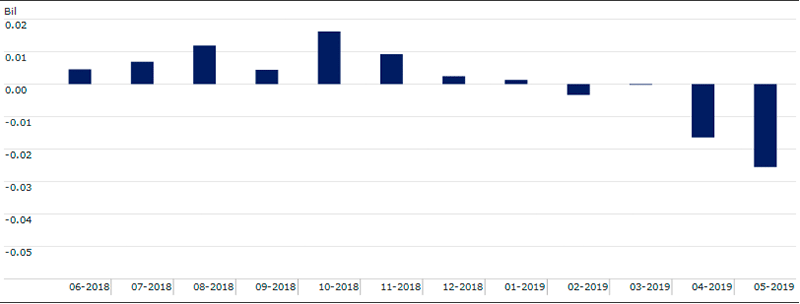Investing basics: pros and cons of investing in gold
Gold is commonly viewed as the ultimate safe-haven asset, but there are different ways of getting exposure beyond buying bullion and some potential traps to be aware of.
Gold has had an incredible year, driven largely by safe-haven buying from investors who fear a global economic slowdown.
The price of bullion jumped above US$1,300 per ounce in January and maintained its gains above that level in February and March after the US Federal Reserve changed its plans to keep on raising rates.
Since then, prices have continued to pick up pace, rising to five-year highs of US$1,404 per ounce.
One year gold price at 27 June 2019

Source: Gold Price
With gold back in the news, we take the opportunity to examine why historically investors have bought gold, some pros and cons, and how to get exposure.
Who uses gold
Gold has many uses including jewellery, electronics, dentistry, medical and other industrial use - and of course investment.
Jewellery is the single-largest individual source of demand, according to Morningstar director of equity research, basic materials Kristoffer Inton, followed by investment purposes, including bars and coins, central bank purchases, and exchange-traded funds at nearly 40 per cent.
Why investors buy gold
Morningstar Investment Management chief investment officer, EMEA, Dan Kemp says investing in gold remains one of the most controversial exposures for an investor, as it is arguably a greater fool investment that is said to be fuelled by three persuasive themes:
- fear of an economic crisis or inflation outbreak fuelling public demand;
- a change in the sovereign wealth funds asset composition, such as demand from China, to diversify their holdings; and
- negative bond yields losing their appeal as an effective hedge against equities.
A save haven
Whether as a hedge against rising tension in the middle east, uncertainty about the direction of the global economy, or rising fears about escalating tensions between the US and China, investors commonly turn to gold as a "safe haven" asset class.
An economic catastrophe like the global financial crisis also causes investors to act to protect their assets. As Graham Hand wrote in last week's edition of the Firstlinks Newsletter:
"On 19 August 2009 in the wake of the GFC, I bought some gold exchange traded funds on the ASX based on a vague notion of protecting my SMSF portfolio and uncorrelated returns."
Morningstar classifies an asset as a safe haven if it holds, or even increases, its value during periods of market and economic uncertainty and downturns. The asset should preserve capital, withstand market volatility, and provide diversification across a portfolio.
Gold – an asset which is virtually permanent, with no significant erosion of quality over time, could arguably be considered a safe haven.
So the song goes:
"Gold
Always believe in your soul
You've got the power to know
You're indestructible
Always believe in, that you are
Gold" - Spandau Ballet
To assess gold's viability as a safe haven, Inton first looked at how gold prices have trended against the US economy.
"Looking at the changes in the real gold price and real GDP growth quarter over quarter since 1990, we see that changes in the gold price hold a weak relationship to US GDP growth. We believe this provides evidence that gold is a decent hedge to US economic cycles."
Next, he looked at how gold prices have trended against equity markets.
"Looking at the changes in the gold price and S&P 500 quarter over quarter since 2000, we believe the gold price's weak relationship to the S&P 500 provides evidence that gold is a decent hedge to equity markets," Inton says.
"We established that gold's functional purposes, including for investment purposes that include safe-haven viability, should be sustainable in the long run."
As a US dollar, inflation or interest rate hedge
Gold has historically served as a hedge against a declining US dollar and rising inflation. As Kemp writes:
"The price of gold often moves in the opposite direction to the US dollar, reflecting the fact that many regard the yellow metal as an alternative currency."
To assess gold's ability to hedge against the US dollar, Inton looked at how gold prices have trended against the real trade-weighted US dollar index.
"During the massive drop in the value of the US dollar from 2002 to 2011, real gold prices rose more than 600 per cent from $250 per ounce to $1,500 per ounce," he says.
"Similarly, a rise in the value of the US dollar after 2011 saw real gold prices drop more than 30 per cent to almost $1,000 per ounce. Given the apparent negative correlation, gold appears to be a decent hedge to the US dollar."
Inton adds that the historical relationship between gold prices and the value of the US dollar shows some evidence that gold provides a "decent" hedge to the US dollar, but not definitive.
"During the past 20 years, lower US dollar values have tended to correlate with higher gold prices," he wrote in 2015.
"While gold isn't a perfect hedge, there is some empirical evidence that it provides a hedge against the US dollar. However, we are reluctant to declare any kind of direct or causal relationship.
"We suspect that rather than the US dollar affect the gold price, the relationship is actually the result of being affected by similar macroeconomic factors, such as inflation and interest rates."
Gold prices have tended to move in the opportsite direction of the US dollar
1990-2018 real gold spot price ($ per ounce) and real trade-weighted US dollar index

Soucre: Bureau of Labor Statistics and FRED
Downsides to investing in gold
For investors seeking income producing assets, gold isn't a viable investment choice as it pays no yield. Also, consider the additional costs.
Investors choosing to purchase physical gold may need to rent outside storage or a safety deposit box to store the physical commodity.
How to get exposure to gold
Investing in gold doesn't mean you have to invest in the physical product. Investors can gain access to gold through exchange traded funds or buying stock in gold miners and associated companies.
Buying physical gold
The most obvious, but conceivably the most time-intensive way is to buy and hold physical gold. This can be done through dealers, who will also value it for you.
Hiding it under the mattress is one way to store it, but probably not the safest. Investors will need to arrange for secure storage, which of course comes with its own associated costs.
Gold ETFs
Arguably the most straight-forward way of getting exposure to gold is via an exchange-traded-product.
In a physical gold ETP, funds take investors’ money and invest directly in the underlying commodity.
For example, the BetaShares Gold Bullion ETF – Currency Hedged (ASX: QAU) invests its assets into the purchase of physical gold bullion (i.e., bars of gold) from the National Bank of Canada. The ETFS Physical Gold ETC (ASX: GOLD) similarly holds physical gold bullion.
"Each share represents a beneficial interest in approximately 1/10th of one fine troy ounce of physical gold held by HSBC Bank USA, N.A., the Custodian Bank, in vaults in London," the fund states.
As gold is valued in US dollars, for a non-US investor buying gold is a joint bet on the price of gold and the strength on the Dollar. For example, an Australian investor may still lose money even if gold prices are rising, if there is a simultaneous drop in the US/AU exchange rate.
Morningstar analysts do not rate any gold ETFs.
Gold stocks
Another way of getting exposure is to invest in listed companies with exposure to gold.
Australian-listed companies include large, long-life gold miner Newcrest Mining (ASX: NCM), and mid-size gold producer Regis Resources (ASX: RRL) – both of which currently screen as overvalued by Morningstar senior equity analyst Mathew Hodge.
Unlike other vehicles, stocks can provide a dividend income, but naturally introduce other variables, including the quality of the mine life, the cost of getting the metal out of the ground, company earnings and other balance sheet considerations.
Is gold a good addition to your portfolio?
As Hand points out, while he made a 61 per cent return off his Gold ETF – purchasing it at $111.52 a share in 2009 and selling it last week for $179.75 – it equates to only 5 per cent per annum (nominal, not real).
"It's better than the S&P/ASX200 Price Index, but less than most growth-oriented super funds with allocations to global equities and listed property," he wrote.
Hand was not alone in selling into the price rally, with gold experiencing the largest outflows of any ETF category on the ASX in May 2019 and over the quarter.
Flows into ETF Morningstar Category - Gold over the one year to May 2019

Source: Morningstar Direct
Morningstar's Kemp is equally sceptical.
"As these commodities have no intrinsic value, returns are governed by the balance of demand and supply together with the degree of speculation present in the market," he says.
"These factors are all extremely difficult to predict and as a consequence, investment in this area has a low probability of success."
Kemp highlights that rather than engaging in speculation, Morningstar focuses on fundamentals – which means our analysis is purely valuation-driven
"This means our analysis of the commodity cycle is purely valuation-driven and leads to a preference for assets that are undervalued relative to a conservative estimate of the cash flow they generate."

